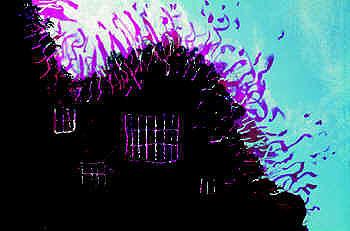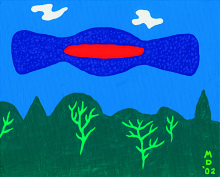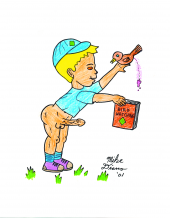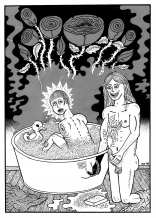| Umělec magazine 1999/4 >> Hang the VJ! (Making Music with Pictures) | List of all editions. | ||||||||||||
|
|||||||||||||
Hang the VJ! (Making Music with Pictures)Umělec magazine 1999/401.04.1999 Vladan Šír | new media | en cs |
|||||||||||||
|
"The club or dance scene has experienced a great boom over the past ten years and inspired birth of numerous styles. It is for its strength, capacity, dynamics and, first of all, freedom that it has gained such significant influence especially but not exclusively among younger audience. Throughout its development, the scene has formed its own institutions and definitions, yet it has managed to maintain its wildness, it has not closed itself and remained open to new people with new ideas, approaches able to absorb and use latest technology.
Still, the club scene is not easy to grasp due to its diversity. It reaches from heart-throbbing gabber, techno with no sign of melody, house, jungle, to calm, meditative chill-out compositions, plus various club bands drawing inspiration from such styles of electronic music. Out of all cultural movements, the club scene is most aware of the variety of interests and preferences. You can find people who rely on sound or visual effects, some of them are there to spread pleasant atmosphere, others pierce their musical or video mixes with political and social commentaries, while work of others is directly based on concrete messages (such as “no government is a way of life“). All together, however, they still form one piece. At first, superficial sight, the club scene may appear to be consisting of mere pounding sound, laser and strobe lights, expensive equipment, computers, but in fact everything that makes up this scene is directed at a person, her/his emotions, experience and opinions more directly and clearly than in case of other art genres. Some people may tell you without hesitation that the club scene (because it no longer is only “dance“ music) changed their lives. They managed to undergo purgatory of rough beats to reveal sounds spaces and waves of effects that perfectly, and unlike anything else, correspond with the chaotic end of the millenium. Film and video have undoubtedly become the strongest visual media of this century and it is natural that they bonded with music, a genre which best captures human emotions. A few years ago, the image was just a visual accompaniment of sound but over time, it has gained an equal position. The way DJs mix vinyls at parties, VJs (video DJ) today may be seen mixing images, movement, fading abstract shapes cut with frames of concrete objects and figures. What dance music manages to express through sound (including sonic citations from music history, television, film and, say, speeches of politicians), VJ can do using images. VJs use various media and technology in their work, reaching from the analogue “old school“ based on slide projection, to video mix (at least two VCRs with a mixer) and digital technology, DVD, computer animations. Wolfgang Spahn, of Berlin’s Tacheles art pool, has been working as a VJ for several years now. He most often uses analogue technology, i.e. slide projectors during his sets, attached to which are various tools and equipment such as rotating magnifying glass, a circle with opening of the size of a slide at opposing sides of it, or just simply his own hand. Using them, he sets his slides into motion, projecting them linearly or one over the another. Seemingly simple process gives way to remarkably strong effects. Despite the fact that Spahn uses predominantly slides, it is interesting that he never uses photography alone. He always manipulates his pictures, draws on them or paints completely new images on slides. Sometimes he also retreats to using computer; digitally processed images, however, serve only as background for other material. Individual slides are also com posed into complicated ”sandwiches“, images composed of two or more slides. “It was boring for me to do just installations,“ says Spahn of his becoming a VJ. “It starts to be interesting to me in connection with music. Music inspires me a lot. I usually work with musicians,“ he says, “they improvise with their music and I make pictures with my slides. I work with a band I know, I know their songs and I try to create a new story for their music. In other cases, I improvise and mix slides.“ VJ Video Virus 23 works both with slides and video. He’s been involved in the business for over a year now. Video made by Virus 23 plays with effects built in either a VCR or a video camera. They are often based on a concrete recording, such as a trip in a car which is then further manipulated in computer software. Virus 23 plays with contrast and color saturation, he discovers possibilities of editing, fading images, focusing and unfocusing. But he really works excellent with a video camera that enables live manipulation of recorded images such as splitting frames into a several separate windows, color filters, delay and others. His videos are full of references to techno scene - images from clubs, open air technivals, or even a recording of a theater performance of African dancers. He was one of the first people involved in video mix and slide projections. “I first saw video mix in Berlin and I was fascinated by it. I wanted to play records but I was a photographer. I saw a great deal of strength in it,“ says Virus of his beginnings. “I’ve been involved in it for quite a short time, I have no schools for it so I’m learning every day. But if you translate the principle of any art, be it music or painting, when you know what it’s about, then all you have to do is to develop understanding for technique.“ Digital generation may be well represented by Geert Mul from Rotterdam of whom Umělec reported in issue 3/99, or Berlin VJs Safi Assaf Etiel and Ron Kazir who were part of the Last Underground event at Roxy club at the end of April. Their set was quite sophisticated, they mixed images stored on CD discs. They were synchronizing movement of their images perfectly with the beats of techno playing in the club. It was quite entertaining for some time and it reminded of a modern silent film with the figures moving exactly to the rhythm of the beat. After a while, their projection lacked a spark as realistic figures turned into comic characters and it all continued in the same manner. Equipment the two VJs were using was impressive including monitors, videos, tons of tapes and CDs. All one remembered of their set were unfortunately the realistic dances to the beat. Overall, the club scene appears as if returning back to the bases of a human being. It speaks of many things, that people commonly do not articulate out of fear of using cliches, with surprising sincerity; you sometimes have to wonder whether those people are so naive as not to know where the world is going today. In contrast to commercial art and commercial pop music, the club scene has content, a load of meanings which may either explode or just dissolve into population, both is fine by the people involved in it. It is turning into a movement which represents values and ideals that are almost forgotten or hollow in today’s information overpressure. Freedom, independence, self-reliance, tolerance. Those for whom the club scene became work agree on a definition of a techno/house party as a ritual where a person learns to become himself/herself again, where he/she comes to relieve their social tensions. What DJs, VJs and other party people have in common is an ability to respond sensitively to their audience. They must have a feeling for what their listeners’ and viewers’ mood is and based on that they serve them further sound and images. DJs and VJs agree that this is the essence of an artist - and quite naturally, they consider themselves artists. "
01.04.1999
Recommended articles
|
|||||||||||||
|
04.02.2020 10:17
Letošní 50. ročník Art Basel přilákal celkem 93 000 návštěvníků a sběratelů z 80 zemí světa. 290 prémiových galerií představilo umělecká díla od počátku 20. století až po současnost. Hlavní sektor přehlídky, tradičně v prvním patře výstavního prostoru, představil 232 předních galerií z celého světa nabízející umění nejvyšší kvality. Veletrh ukázal vzestupný trend prodeje prostřednictvím galerií jak soukromým sbírkám, tak i institucím. Kromě hlavního veletrhu stály za návštěvu i ty přidružené: Volta, Liste a Photo Basel, k tomu doprovodné programy a výstavy v místních institucích, které kvalitou daleko přesahují hranice města tj. Kunsthalle Basel, Kunstmuseum, Tinguely muzeum nebo Fondation Beyeler.
|




































 We Are Rising National Gallery For You! Go to Kyjov by Krásná Lípa no.37.
We Are Rising National Gallery For You! Go to Kyjov by Krásná Lípa no.37.
Comments
There are currently no comments.Add new comment